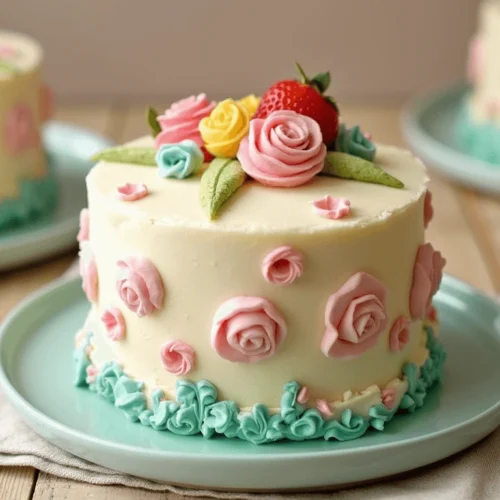
Fondant cake
Avoid cake disasters with these expert tips! Discover the Fondant Cake Mistakes You Must Avoid Now and learn how to fix them for a flawless finish.
Ingredients
For the Cake Base
- A sturdy cake is essential for supporting fondant. Opt for a dense cake that holds its shape well. Some great choices include:
- Vanilla sponge cake – A classic firm base that pairs well with fondant.
- Chocolate cake – Rich and stable providing a great foundation.
- Butter cake – Dense enough to support fondant without crumbling.
- Carrot or red velvet cake – If using these apply a firm crumb coat for extra stability.
For the Buttercream Crumb Coat
- Before applying fondant a smooth crumb coat helps it adhere properly and prevents bulging. You’ll need:
- 1 cup unsalted butter room temperature
- 3 cups powdered sugar sifted
- 2-3 tablespoons heavy cream adjust for desired consistency
- 1 teaspoon vanilla extract or your preferred flavoring
- Tip: A thin even layer of buttercream provides a tacky surface for the fondant to stick to, preventing air pockets.
For the Fondant
- If making homemade fondant these ingredients will help achieve the perfect texture:
- 16 oz mini marshmallows – Melted to form the base.
- 4 cups powdered sugar – Adds structure and sweetness.
- 2 tablespoons water – Helps melt the marshmallows smoothly.
- 1 teaspoon vanilla extract – Enhances flavor.
- Vegetable shortening – Prevents drying and cracking while kneading.
- Cornstarch or powdered sugar – For dusting while rolling out fondant.
Optional Additions:
- Tylose powder – Strengthens fondant for sculpting decorations.
- Gel food coloring – For customizing colors without altering fondant texture.
- Edible shimmer dust – Adds a professional finishing touch.
Instructions
Step 1: Prepare and Level the Cake
- A solid foundation is key to preventing fondant cracks or bulging. Here’s how to prep your cake:
- Cool the cake completely before handling—warm cakes can cause the fondant to melt or slip.
- Trim and level the top of each layer using a serrated knife or cake leveler to create an even surface.
- Apply simple syrup (optional) to keep the cake moist without making it soggy.
- Tip: A dense cake (like butter cake or sponge cake) holds its shape better under fondant than a light, airy cake.
Step 2: Apply the Crumb Coat
- A smooth buttercream base prevents fondant from slipping and helps it adhere properly.
- Spread a thin layer of buttercream over the entire cake using an offset spatula.
- Chill the cake for 30 minutes to let the crumb coat firm up—this prevents the fondant from picking up crumbs.
- Apply a second coat if needed to create an even, smooth surface.
- Tip: The smoother your buttercream base, the better your fondant will look.
Step 3: Roll Out the Fondant
- The right rolling technique makes all the difference in achieving a wrinkle-free fondant finish.
- Dust your work surface lightly with cornstarch or powdered sugar to prevent sticking.
- Knead the fondant until it’s soft and pliable—this prevents cracks and air bubbles.
- Roll out the fondant into a circle about 1/8 inch thick and at least 2 inches wider than your cake’s diameter.
- Tip: Use a fondant rolling pin to ensure an even thickness across the surface.
Step 4: Cover the Cake with Fondant
- This is the trickiest part, but with the right approach, you’ll get a smooth, seamless finish.
- Carefully lift the rolled-out fondant using a rolling pin or your hands.
- Drape it gently over the cake, ensuring it covers the entire surface.
- Use a fondant smoother to press the top and sides, eliminating any air bubbles.
- Work your way down the sides, gently pulling and smoothing to prevent wrinkles.
- Trim the excess fondant at the base with a sharp knife.
- Tip: If air bubbles appear, use a small pin to gently release the air, then smooth over the spot.
Step 5: Add Decorative Touches
- Now for the fun part—decorating your masterpiece!
- Use embossing tools or textured mats to create unique patterns.
- Apply gel food coloring for custom designs.
- Dust with edible shimmer powder for a polished, professional look.
- Create fondant cutouts or figures to personalize the cake.
Step 6: Store and Serve
- To keep your cake fresh and looking perfect:
- Store at room temperature in a cool, dry place. Refrigeration can cause condensation, making the fondant sticky.
- Use a cake box when transporting to protect the fondant finish.
- Slice with a sharp knife, wiping between cuts for clean edges.
Notes
Nutrition Information (Per Serving):
- Calories: 420 kcal
- Total Fat: 12g
- Saturated Fat: 7g
- Cholesterol: 55mg
- Sodium: 180mg
- Carbohydrates: 72g
- Sugars: 55g
- Protein: 4g
- Fiber: 1g